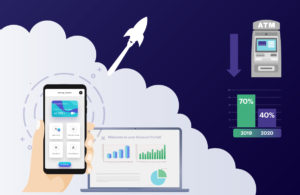March 23, 2021 | 5 min read
Is digital banking meeting expectations?



*Information is based on Marqeta’s 2020 and 2019 surveys, as applicable
Like almost every sector of the market, the pandemic has left its mark on the banking industry, forcing traditional and non-traditional banks to speed up innovation and adapt to the digital-first preferences of the COVID-19-era consumer. The speed of change in banking was already pronounced, but the trials of 2020 only accelerated it. Challenger banks offering a suite of digital programs have been able to stay ahead of the curve, but aren’t the only ones adjusting to the growing demand for flexible banking options. A recent survey we conducted with Propeller Insights in August 2020 of 2,000 consumers shows how the pandemic has made banking more inherently digital and amplified the arms race traditional banks are in to keep up.
Virtual banking experiences took flight in 2020
According to the August survey, over half of consumers said that COVID-19 has impacted how they do their banking. In an industry that was already in flux, this marks a significant evolution. As the pandemic gave flight to the virtual experience, consumers came to expect virtual offerings in everything they do, including their banking. Consumers who reported visiting physical branches in 2020 dramatically reduced in numbers: 12% of respondents said they had gone to a physical branch to do their banking in the last month, compared to 46% who said they had done so the year prior.
Additional data from our recent survey that shows the rise of digital banking include:
Five times as many people now use their bank’s mobile app monthly (66%) as those who go to a physical branch monthly (12%).
ATM use fell by over 40% in 2020: 70% of consumers in 2019 said they used an ATM at least every 3 months, down to 41% in 2020.
Tech-savvy Gen Z and Millennial age groups aren’t the primary drivers of shift to digital banking
Gen Z and Millennial demographics instinctively get a lot of the credit for driving the shift toward digital banking. According to our survey, it’s the slightly older consumer, the 35-50-year-old age group, that is searching for real innovation in banking. This group was almost 50% more likely than average (73% against 50%) to express dissatisfaction at its bank’s digital banking experience.
This wasn’t the only statistic that made the 35-50-year-old age group stand out:
Seventy-two percent of 35-50-year-olds said they would switch to Google, Facebook, or Amazon if they offered banking services, compared to 51% total overall.
Almost three-quarters (72%) of 35-50-year-olds said they would consider moving to an independent non-traditional bank over a traditional bank, compared to 50% of 18-34-year-olds.
Fifty-two percent of 35-50 year-olds said they were thinking about switching banks right now, compared to 32% overall.
This age group tends to have the most complex financial needs: children, mortgages, aging parents, while still years away from retirement. Their banking needs are at the top of their minds, and modern banking technologies bring the simplicity to their lives that they’re looking for. While Generation Z and young Millennials are making decisions about who to bank with for the first time, 35-50 year-olds are experienced and mindful of what they need from their bank: a more digital-centric offering. As consumers age, we can expect this trend to continue, with those more engrossed in their finances seeking out the most flexible and convenient banking options.
COVID-19 has propelled digital banking forward but hasn’t changed attitudes towards digital-only challenger banks
While only 32% of all consumers surveyed said they are currently looking to change their bank, half of the consumers surveyed said that they want their banks to improve their digital banking experience. Digital banking capabilities have become a necessity, requiring traditional banks and large financial institutions to reshape their businesses and develop new technologies to optimize the customer experience. Although banking has gone digital during COVID-19, consumers haven’t significantly shifted their attitudes towards digital-only challenger banks: 49% of the consumers we surveyed in 2019 vs. 51% of the consumers we surveyed in 2020 said they would consider digital-only banking over traditional banks.
Digital-only, non-traditional banks often have the upper hand in bringing new features to market quickly. However, there are numerous traditional banks that have begun to invest in new digital banking opportunities for their customers, including J.P. Morgan and their virtual commercial cards program, and Marcus by Goldman Sachs, who are building a digital consumer bank from the ground up. In the wake of COVID-19, the legacy of the leading traditional banks might come down to their ability to digitize their programs and keep pace with fintech alternatives.
Read part one of Marqeta’s State of Payments report here.
Read part two of Marqeta’s State of Payments report here.
Read part three of Marqeta’s State of Payments report here.
________________*Marqeta consumer research survey of 2,000 Americans by Propeller Insights, October 2019
*Marqeta consumer research survey of 2,000 Americans by Propeller Insights, September 2020
